Zbrush Unable to Read Virtual Memory File
15Jun/11
ZBrush Insufficient Memory Error
The dreaded ZBrush retentivity mistake reared its ugly head as I was trying to create a 4096x4096 adaptive displacement and adaptive normal map for the velociraptor model.
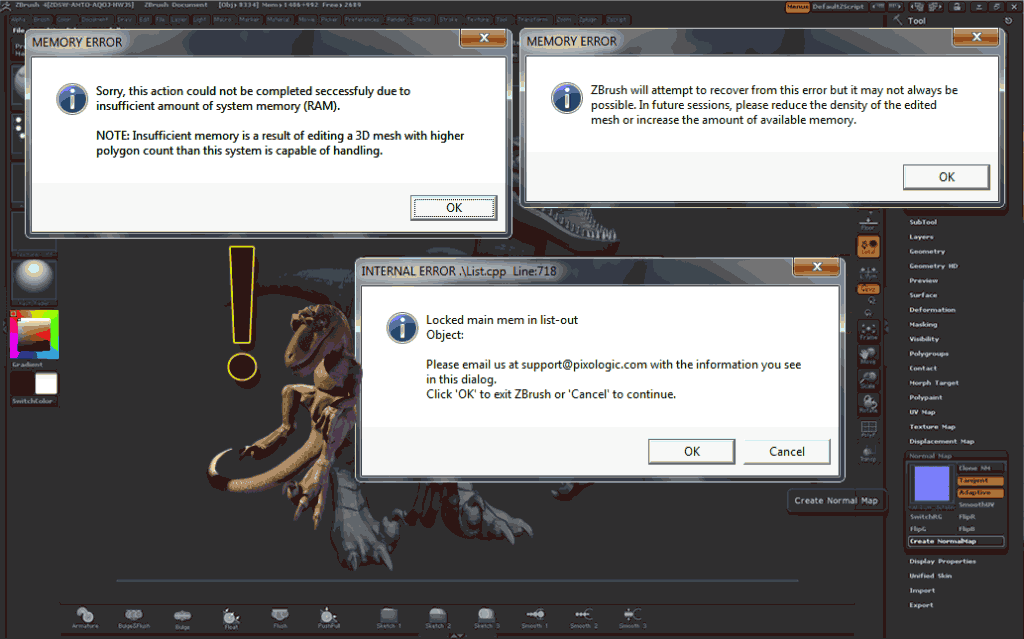
ZBrush Retention Error dialogues crashing the scene.
At the highest subdivision, the raptor model reached 13.4 million points. While taxing to the system, ZBrush handled sculpting at the highest subdivision with ease. Our system is pretty beastly and has more RAM than the current 32-bit version of ZBrush tin can utilise, and then I was a scrap confused to see the Retentiveness Fault dialogue appear. Instead of abandoning my piece of work and reducing the model complexity, I decided to consult The Net.
Equally it turns out, insufficient retentiveness errors tin can be caused by numerous issues which all have their own fixes. For reference, our machine was running Windows 7 64-bit SP1 and had enough of RAM.
Run ZBrush with administrative rights
Some users reported having luck past simply running ZBrush with authoritative rights. If you right click on the icon to launch ZBrush, you lot can choose Run as Administrator to run ZBrush with administrative rights once, or you can modify a shortcut that launches ZBrush to e'er run the application with administrative rights. To do this, right click a ZBrush shortcut, cull Backdrop, and then go to the Compatability tab and check the box next to Run this program as an administrator. This will modify the shortcut icon to appear with a shield (run across image).
Increase the RAM and virtual retentiveness available for ZBrush
Increase Compact Mem if yous have the RAM
You may be able to ready the error by simply providing ZBrush with more RAM or virtual memory. You can increase the RAM bachelor to ZBrush past increasing the Compact Mem value. Be conscientious to go out some RAM for your operating system and background processes. For instance, if you have four GB of RAM in your car, do non increase the Auto Compact Retentivity slider to a higher place around 3 GB. When the Auto Meaty Memory value is the reached, ZBrush issues a Compact Now event and uses your virtual memory.
To verify you have plenty virtual memory, outset, cheque that your harddrive isn't total. Then, Run (Windows Key + R) systempropertiesadvanced.exe (or Correct Click on Estimator, become to Properties, then choose Advanced Properties), go to the Advanced Tab, and cull the Performance > Settings... push button. Finally, pick the Advanced Tab (again) and click the Virtual memory > Change... button. My virtual memory is effectually two times my concrete memory/RAM at 32,000 MB.
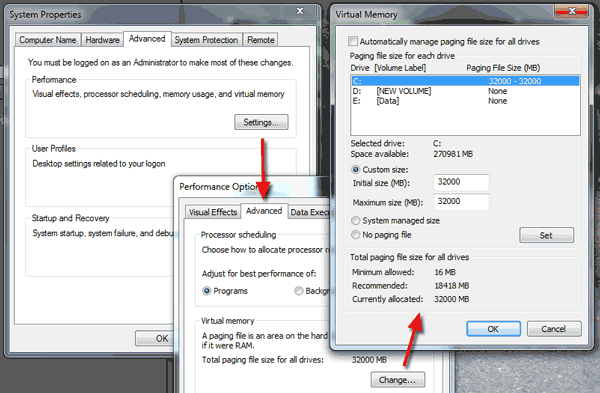
Arrange virtual retentivity in Windows
Fix inverted or overlapping UV coordinates
Improper UVs tin can give ZBrush a hard time, specially when it tries to generate a normal map or displacement map. Though not every bit fast or efficient as working in 3ds Max, ZBrush has tools to help you notice and set overlapping UVs without leaving the program (notwithstanding, if you made the UV map using ZBrush's UV Master, you may not have this problem to brainstorm with!).
Use ZBrush to fix inverted or overlapping UV coordinates
In ZBrush, you lot tin employ the Tool > Texture Map > New From UV Bank check button to create a texture map for your current subtool that highlights overlapping UV coordinates in reddish. The balance of the model should be a shade of greyness. If y'all have Draw Poly Frame (Shift + F) active, the New From UV Check button also draws a wireframe on the texture map which can brand it easier to locate overlapping UV coordinates. If you open the texture map in Photoshop, you lot tin can cull Select > Color Range... and Select: Reds to aid highlight their locations. Once you've located the offending face up, yous'll need to adjust the UV map. I'm not a big fan of this method considering it tin can be difficulty to find and fix overlapping faces in ZBrush and I don't think there'due south any way to aid locate inverted faces. Instead, I prefer to use the Unwrap UVW modifier in 3ds Max.
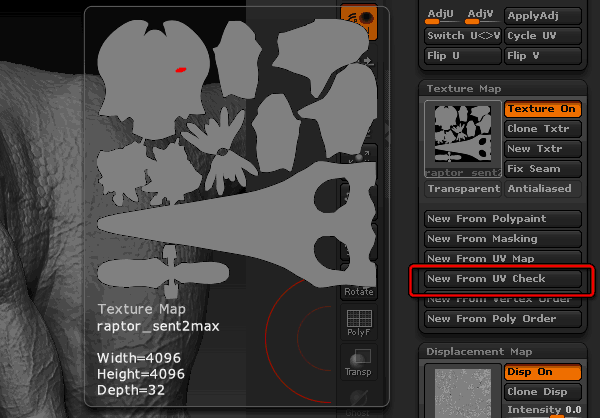
The New From UV Bank check push in ZBrush highlights overlapping faces in red.
Utilise 3ds Max to ready inverted or overlapping UV coordinates
Use GoZ or export and import your model to 3ds Max (do information technology with the same level you created the UV map with, if possible to make working with easier). Select the model and add an Unwrap UVW modifier to the stack. Open up the UV Editor and select the face sub-object or press the number 3. Then choose Select >Select Overlapping Faces. Whatever overlapping UVs will be selected and you can simply zoom in and ready the problem areas. Furthermore, in 3ds Max, you can also check inverted faces past using the Select > Select Inverted Faces card item. When you're done, send it back to ZBrush using the GoZ menu or by consign / importing the model to ZBrush.
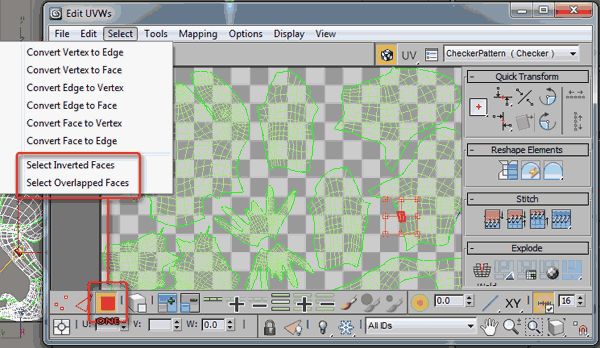
Utilise the Unwrap UVW modifier in 3ds Max to quickly locate and set up both inverted and overlapping faces.
Reduce the retention ZBrush is trying to asking
If you're willing to sacrifice a particular, y'all can disable the Adaptive Browse Style for the displacement map or normal map, or reduce the UV Map Size. If the finest details wont show up on your model anyway, you could also remove the highest subdivision of your model.
If you're not willing to cede detail, you could reduce the geometry of your current subtool earlier creating the texture map, normal map, or deportation maps. You can either alter your mesh'due south topology past retopologizing or optimizing your model or you tin can split the model into multiple subtools by polygroup, create your maps for each subtool and stitch them together in Photoshop. More on this step, below.
Reduce total points without reducing complexity
If you're truly hitting the retentiveness max and are willing to do a little work, you can explode your current subtool into multiple subtools based on their polygroups. If you haven't already, you tin use the Tools > Polygroups > Auto Groups With UV button to create polygroups based on the islands you defined for you UV map.
Next, go to the tiptop level of your geometry and printing the Tools > SubTool > Groups Split button to create subtools for each poly grouping. Past pressing the Groups Carve up button on the top subdivision level, your model will retain detail and each of the lower subdivisions.
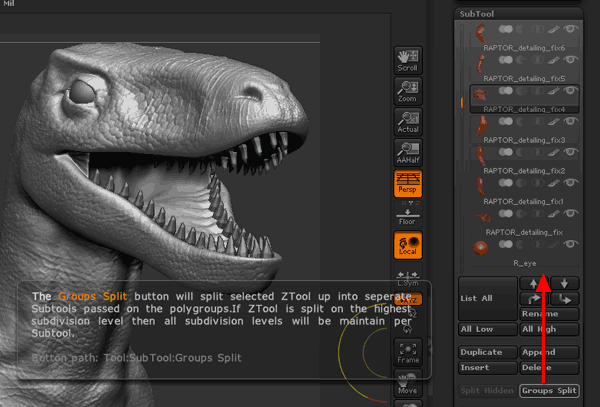
Dissever your subtool based on its polygroups.
With fewer points to compute per level, ZBrush may now have enough memory to make the texture map, displacement map, or normal map at the resolution and detail you desire. You may want to plummet subtools together then you have fewer maps to create and consign. Either style, before you can use the maps, you'll need to combine them in Photoshop.
A raptor, saved!
After fixing a couple inverted and overlapping faces, I was able to consign an Adaptive Displacement map with a DisplacementMap Subpixel Accurateness of two. However, ZBrush 4 continued to crash when trying to create an Adaptive Normal Map. Mayhap I was truly hit the retentivity max. As such, I could either reduce the UV Map size (non going to happen), disable the Adaptive Scan Style, or reduce the number of total points in the model. Feeling stubborn, I decided to divide the subtool, export a agglomeration of normal maps, and combine them back together using Adobe Photoshop.
norrissdenard1995.blogspot.com
Source: https://www.offsetnull.com/zbrush/zbrush-insufficient-memory-error/
0 Response to "Zbrush Unable to Read Virtual Memory File"
Post a Comment